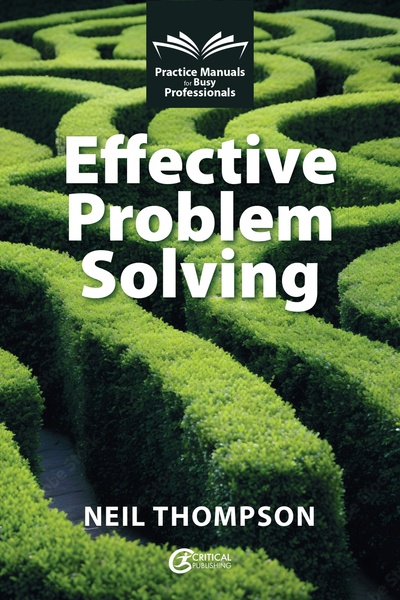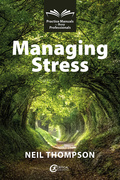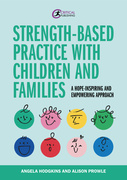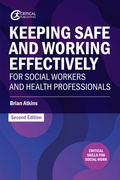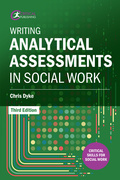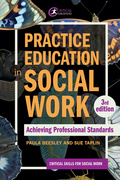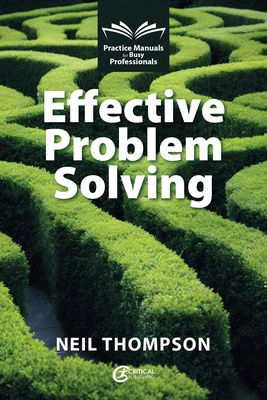
Recommend this title Review this book
Tags: Business, Nursing, Policing, Social Work
Discounts are available for bulk orders. More details
Effective Problem Solving
AUTHOR : By Neil Thompson
ISBN : 9781916925373
Edition No : 2
Publication : Oct 21, 2024
Extent : 320 pgs
ISBN : 9781916925380
Edition No : 2
Publication : Oct 21, 2024
Extent : 320 pgs
ISBN : 9781916925397
Edition No : 2
Publication : Oct 21, 2024
Extent : 320 pgs
Description
A bumper book of powerful problem-solving tools and techniques presented clearly and concisely by a highly respected author.
Practitioners across the range of human services and managers in all sectors are constantly faced with problems of various kinds. Each of these is unique, however there will be general patterns that we can learn from. This book draws upon the author's extensive experience in teaching and training problem-solving, providing students, practitioners and managers with a powerful repertoire of tools that can make a real difference in a wide range of situations.
This easy-to-read text incorporates new challenges in the modern workplace such as the new world of AI, increased job insecurity and neurodivergence in relation to problem-solving. Also discussed is the role of problem-solving concerning our biggest challenge - safeguarding our habitat. Packed with critical exercises and opportunities for reflection, it encourages readers to analyse the difficult situations they find themselves in and how to respond to these challenges head-on, making a real impact.
Effective Problem Solving delves deep into the vast array of problems individuals in the workplace find themselves with, making it a handy guide that will increase readers' skills and confidence.
Contents
About the author
Acknowledgements
Preface
Foreword
Introduction: who, why, what and how
Why a manual?
How do I use it?
PART 1: Understanding people and their problems
- Introduction
- What is a problem?
- What is a ‘people’ problem?
- Why is the context important?
- How do we start?
- How do we get people motivated?
- How do we find the right way forward?
- How do we promote change?
- Why do we need PRECISE practice?
- What are the challenges involved?
- Is there a problem-solving process?
- Is a problem always an opportunity?
- What is the role of reflective practice?
- How do we make things happen?
- Conclusion
PART 2: Problem-solving methods
Introduction
Important notes
A Active listening
- Show that you are paying attention
- Avoiding attribution errors
- Avoiding oversimplifying the reasons for people’s behaviour
- Avoiding avoidance
- Facing up to our responsibilities
B Brainstorming
- Maximising our range of options
- Brokerage
- Redirecting people to sources of help
C Capitalizing on crisis
- Realizing the potential of critical moments in a person’s life
- The CBC approach - Putting people at their ease
- Challenging cognitive distortions - Trying to get a balanced view of the situation
- Chunk up or chunk down - Finding the right level of analysis
- The CIA framework - Managing pressure and stress
- Circular questioning - Establishing the importance of interrelationships
- Confronting without being confrontational - Using assertiveness skills
- Congruence -Getting on the same wavelength
- Consequences - Exploring options and their likely outcomes
- Cost-benefit analysis - Balancing the pros and cons
- Creative tension - Making sure expectations are realistic
- Critical incident technique - Learning from significant experiences
- Culture audit -Making sense of organizational cultures
D Dealing with objections
- Persuading people to move forward
- Developing a checklist Save time and efforts with checklists
- Doing the right things versus doing things right Balancing efficiency and effectiveness
- The drama triangle Avoiding being drawn into being a ‘rescuer’
E Eating an elephant
- Being realistic about what we can achieve
- Eco maps - Mapping out relationships across groups of people
- Educating - Problem solving through helping people learn
- Elegant challenging - Being constructive in challenging unacceptable behaviour or language
- Embedded whys - Establishing reasons for our actions
- The empty chair - Exploring the influence of an absent person
- Encouraging creativity - Avoiding getting stuck in ruts
- Exchange is no robbery - The importance of reciprocity
F Failure mode and effects analysis
- Anticipating failure and learning from it
- Finding the growth zone Finding the balance between comfort and fear
- Fishbone analysis A visual aid to problem solving
- Fishing for red herrings Not allowing ourselves to get distracted
- Force-field analysis Managing change
- FORM good habits Use habits to gain greater control
G Gantt charts
Visual aids for project management
- GIVE UP How to let go of negativity
- Giving feedback Letting people know where they stand
- Grief audit Getting an overview of people’s experiences of grief
Helicopter vision
- Obtaining an overview
- Holding Helping to provide emotional security
I Inviting innocent questions
- Getting a perspective from outside the situation you are dealing with
K Know your enemy
- Coping with anxiety
L Lateral thinking
- Finding new ways to think about problems and solutions
M The magic wand
- Getting as close to the ideal as possible
- Making the most of meetings - Avoiding time and energy being wasted
- Mind mapping - Developing a picture of the situation you are dealing with
- Mitigate the effects - Minimize the effects
- Modelling and use of self - Using yourself as a tool to help others
- Motivational interviewing - Using ambivalence to bring about change
- Motivation audit - Getting an overview of key motivational factors
N Naming the process
- Bringing hidden agendas out into the open
- Negotiating expectations Being clear about what we can expect from each other
- Not tolerating vagueness Avoiding the dangers of being too vague
O Objectives tree
- A framework for helping to develop plans
P Paint the toilets
- Making a fresh start
- The paradoxical approach - Reducing behaviours by encouraging them
- PCS analysis - Understanding different levels of discrimination
- Peacemaking circles -Drawing on Native American wisdom
- PEARLS - Building relationships
- Positive strokes Building confidence
- Principled negotiation - Constructive ways of reaching agreement
- Promoting realism - Getting a balance between optimism and pessimism
- Providing an anchor - Providing security in times of instability
- Pushing the buttons - Acting as an advocate
R Radical non-intervention
- Allowing situations to resolve themselves
- RAID - Reducing problematic behaviours
- REBT - Understanding anger
- Recognising grief - Appreciating the significance of loss and grief
- The RED approach - Managing conflict
- Reframing - Redefining problem situations to allow people to move forward
- Releasing the scapegoat - Avoiding the destructiveness of blame
- Responding to feelings - Taking account of the emotional dimension
- Revisiting assumptions - Questioning the premises
- The right person for the job - Matching skills and aptitudes to tasks
- Risk assessment - Analysing the risks involved in a given situation
- Role reversal - Seeing the situation from someone else’s point of view
S SARAH
- Coping with emotional intensity
- Serendipity - Making the most of chance occurrences
- The six thinking hats - Looking at the different angles
- SMART objectives - The importance of having clear goals
- SOLER - Managing interpersonal relations
- Start – Stop – Continue - Optimising a situation
- Stop trying! Taking a break from our efforts can sometimes be helpful
- Storytelling - Using stories to gain fresh insight
- Stress audit Getting an overview of pressures, coping methods and support
- SWOT analysis - Balancing positives and negatives as an aid to decision making
T Think–feel–do
- Taking account of the three dimensions of human experience
- The three Hs - Understanding what motivates people’s behaviour
- The three Rs - Drawing on strengths
- TOTE - Testing out the changes we make
- Transactional analysis - Understanding interpersonal dynamics
- Tuning in - Making connections with the people we are trying to help
- Typology of objectives - Prioritising what you are trying to achieve
U Using an accountability partner
- The importance of supportive reminders
- Using dissonance - Challenging ingrained views
- Using personal constructs - Developing our own theories
V Visioning
- Developing a vision of the place we want to get to
W Working backwards
- Keeping a clear focus on outcomes
- Worst case, best case
Getting things in perspective
Guide to further learning
References
Author
Neil Thompson is an independent writer, producer of online learning resources and a visiting professor at the Open University. His approach is based on the three Ps: where there are People, there will be Problems, but there will also be Potential. He has decades of experience helping individuals and organisations to address the problems and fulfil the potential.
He is renowned for his ability to express complex ideas clearly and accessibly without oversimplifying them and to successfully blend theory and practice. In a long career, he has provided training or consultancy services to over 100 organisations, spoken at conferences and seminars in 13 different countries and has won awards for the quality and impact of his work. He has held full or honorary professorships at five UK universities, but for many years now he has focused on reaching a much wider audience to help make a positive difference. He has earned the trust to be a helpful guide and mentor through his writings and online learning and you will no doubt soon see why when you start reading this book. His Academy website, with his Manifesto for Making a Difference, is at www.NeilThompson.info.
Publication Overview
Availability:

